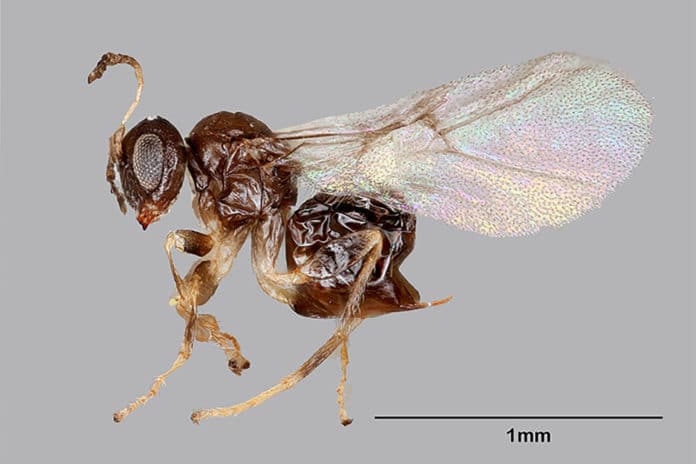Biologists at Rice University have discovered new insect species called Neuroterus (noo-ROH’-the-rus) Valhalla. It is the first insect species to be described alongside its fully sequenced genome.
The newly discovered insect species is just a millimeter long. It spends 11 months of the year locked in a crypt.
Biologists discovered the insect just outside the Rice graduate student pub Valhalla.
Graduate student Pedro Brandão-Dias, a lead author of the paper, said, “It would have been a missed opportunity not to call it something related to Rice or Valhall.”
Biologist Scott Egan said, “At Rice, we emphasize learning by doing. In my lab, undergraduate and graduate students share in the experiential learning process by studying biologically diverse ecosystems on the live oaks right outside our front door. Armed with some patience and a magnifying glass, the discoveries are endless.”
Like other gall wasps, N. Valhalla tricks their host tree into feeding and sheltering their young. There are almost 1,000 known species of gall wasps. Some emerge from spherical brown galls that form on the underside of oak leaves, whereas others form galls inside branches and others on the trees’ flowers.
Brandão said, “Once they emerge, they only live three or four days. They don’t eat. Their only purpose is to mate and lay eggs.”
It took almost four years to describe the new species because N. Valhalla — like many other galleries — lays eggs two times a year. Finding where N. Valhalla laid its eggs in its alternating generation took a bit of time.
N. Valhalla lays their eggs into the catkins that are developing. They develop in galls on the flowers, and then they emerge. And that happens in March. But the flowers are a one-time thing each year, and by the time they appear, there are no more flowers for them to lay eggs on. So they have to lay eggs on different tissue.”
Egan said alternating generations of gallers have often been mistaken for new species in the past. Genomic testing combined with detailed observations in nature was crucial for determining N. Valhalla was a unique species. Finding out where the insects went in their alternate generation took both luck and hard work.
Scientists sampled the galls from a Florida live oak species. They found that these Florida live oak species differed from the Rice trees where N. Valhalla was found. Further analysis revealed that the unknown wasps were the lost generation of N. Valhalla.
Brandão said, “To confirm where they were going after they left the flowers, I performed an experiment where we offered the wasps a bunch of different tissues from the tree and observed them. The idea was to watch N. Valhalla that had just emerged from catkin crypts at Rice and catch them in the act of laying their eggs into a different part of the plant.”
“We would go out together and collect the catkin galls and tissues for the behavioral tests in Petri dishes, but she had to go every day to the lab to see if any bugs had emerged. Vinson both cataloged and collected samples of wasps that emerged from the catkins and did the observation experiment where we’d put the bugs into a petri dish with a bunch of tissues and then watch to see where they go.”
“Because this was during COVID, I took some of them back home and put them in the microscope and took pictures with my phone.”
Brandão said, “the N. Valhalla generation that hatches in live oak catkins goes from eggs to fully formed adults in 2-3 weeks. The cycle takes 11 months for the generation that grows inside branches.”
“If they come out at the wrong time, and there are no flowers around, they can’t lay their eggs, and they die. They have to come out at the exact time the tree’s flowering.”
Other co-authors of the study include Weinersmith, Forbes, Ward, Miles Zhang of the Department of Agriculture’s Systematic Entomology Lab at the Smithsonian National Museum of Natural History and Stacy Pirro of Iridian Genomes Inc.
Journal Reference:
- Pedro F. P. Brandão-Dias et al. Describing biodiversity in the genomics era: A new species of Nearctic Cynipidae gall wasp and its genome. DOI: 10.1111/syen.12521
